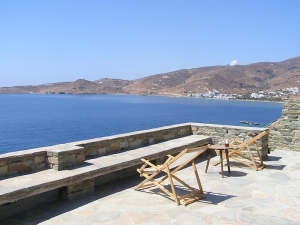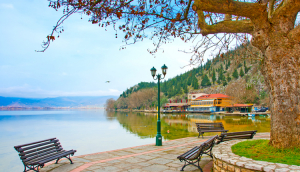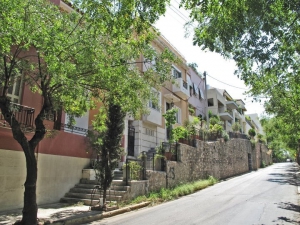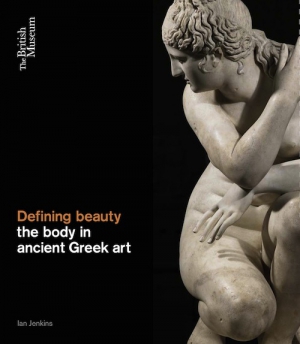COMMUNITY CORNER
XpatAthens
Tinos Seaside Houses
The houses offer magnificent views of the sunset. They each have 2 bedrooms (one with a double bed and one with 2 single beds), a living room with fireplace, dining area and kitchen, one bathroom and a WC. The kitchen is fully equipped with stove, fridge and, coffee maker, toaster and a TV and DVD can be provided upon request. There are pull-out couches so extra sleeping arrangements can be made when needed. The seaside views are wonderful as are the evening sunsets. Twice a week cleaning and changing towels, bed linen once a week included.
Tinos is truly ”Greek ” island ideal for your holiday because you can combine swimming, walking, sightseeing and many other activities. Tinos is a particularly interesting island because, except for the main port and its town there are 40 villages that are worth visiting. There are museums and cultural events and there are wonderful paths for hiking. Of course there are many beaches but it is also a beautiful island to visit at times other than the summer. If you enjoy eating there are many restaurants with delicious traditional Greek food. Tinos is very easy to get to from the ports of Rafina and Pireas and is also close to many other Greek islands so the location enables you to do some island hopping. Some of the near by islands are Myconos, Andros, Paros, Milos, Naxos and a little further away Santorini.
Breakfast In Athens
I’ve said it before – Athens has never been a huge brunch city. It’s a fairly recent phenomenon, but one that has grown fast. You can actually get some pretty good brunch fare at a growing number of cool spots around town.
I came across a list of Athens brunch places, which I will share here. This is surely not the ‘whole’ list – but it does have a few interesting suggestions.
· The Handlebar – originally a stop-in for cyclists to refuel while getting their bikes fixed, this is now a super-popular Psirri hangout, perfect for a cool, no-nonsense breakfast.
· To Tsai – bistro-style tea house in Kolonaki also serving breakfast, with interesting tea tastings, Chinese tea rituals, etc.
· Mama Roux – great food, good selection, lots of vegetarian options in Monastiraki.
· Hip Café – my personal favourite, healthy and easy, indoor/outdoor seating, very central.
· Prytaneion – well-known spot in Kolonaki – for brunching with businessmen, journalist and politicians.
· Jimmys Coffee Shop – a classic, around for more than 30yrs, and opens from very early.
· Acropolis Museum Restaurant – traditional Greek treats with an incomparable backdrop.
· New Taste – inside the New Hotel, this is becoming the ‘must try’ breakfast spot.
· St. George Lycabettus Hotel – Greek and American style selections – nice view!
· Hilton Athens – this one also has some Chinese selections on the list.
And I know there are plenty more options around! So, I think I will take my friends up on the brunch invites – especially this Sunday with the shops remaining open. Maybe this means I should also dust off my bike…
Until next week,
Jack
http://www.10best.com/
Athens International Airport Dubbed 'Airport Of The Year'
Athens International Airport (AIA) was named “Airport of the Year” in the 10-30 million passengers category at the Air Transport News (ATN) 2015 awards ceremony that took place in Geneva. The ATN Awards are the only international prizes that award all the main categories of the air transport industry.
“2014 has been a year of spectacular traffic development for our airport, which demonstrated an increase of 21.2 percent, within a very critical economic and political situation in Greece”, said AIA’s CEO, Yiannis Paraschis.
According to Mr. Paraschis, during the recent years marked by the Greek macroeconomic crisis, AIA managed to address significant market challenges, protect its business model and continue to deliver substantial value to all stakeholders and the Greek economy.
“Targeted efforts towards incentivizing traffic development and enhancing Athens’ attractiveness as a tourist destination have been key to that end”, he said.
“We believe that what makes an organisation capable of weathering a storm and come out even more efficient and effective, is clearly the ability of its human capital to continuously change and adapt. The Air Transport News award is yet another recognition for the people of AIA and the airport community at large.”
To read more please visit: GreekTravelPages
Greek Shares Present Opportunities
Veteran investor Mark Mobius of Templeton's emerging markets Investment Trust told Greek financial daily Naftemporiki on Tuesday that Greece's stock market was cheap and that the country would remain in the single currency club.
"Greece will stay in the euro zone, there is no issue," Mobius, who is in Athens for company visits, told the paper. "The stock market is cheap and we are buyers."
Uncertainty over the Greek government's negotiations with its official creditors to unlock remaining bailout funds has hurt the stock market, with the Athens bourse's blue-chip index down 14 percent year to date.
Mobius said privatisations are key to attracting foreign investors in Greece and improving the market climate.
To read more please visit: Reuters
Most Beautiful Towns In Greece
A land of incredible natural beauty, fascinating history, and colorful folklore, Greece arguably has something for everyone. From quaint coastal towns to alpine mountain villages and multicultural Macedonian cities, this is a selection of the must-visit, off-the-beaten-path destinations where you will discover a different side of this remarkable country.
1. Nafplio
Few cities reflect Greece’s rich and diverse history as well as Nafplio, one of the country’s most elegant and romantic destinations. Located in the heart of the historic Argolis region on the Peloponnese peninsula, Nafplio has deep cultural roots in Ancient Greece and the Venetian period of the 15th and 17th centuries. It flourished as modern Greece’s first capital in the early 1800s. The city boasts gorgeous neoclassical mansions, beautiful Venetian architecture and scenic alleys. Its landscape is composed by two Venetian castles, Palamidi and Acronafplia, built on two successive hills. Not to be missed, the small fortress of Bourtzi in the Argolic gulf, a short ferry ride from the city, offers unique views over Nafplio and an ideal setting for romantic getaways.
2. Parga
The quaint town of Parga is the most popular summer destination in Epirus, in western Greece. Built amphitheatrically on the slopes of Pezovolos hill and surrounded by lavish greenery and beautiful blue sea, the town has a laid-back island feel to it. Amongst Parga’s highlights, the visitor can enjoy its charming and colorful waterfront houses and stone-paved squares, and visit the ruins of an old Venetian castle atop the hill. Nearby Valtos and Lichnos beaches, connected to the port of Parga by boat, are amongst Greece’s finest.
3. Kalampaka
With a population of roughly 12,000 people, the small town of Kalampaka is located in Central Greece. It is built on the foot of the most spectacular Meteora pinnacles, a complex of abrupt rock formations that host one of Greece’s biggest and most important group of monasteries and UNESCO World Heritage site. Kalampaka has a rich history dating back to ancient Greece and especially the Byzantine era, with plenty of beautiful Orthodox churches and chapels. You can stroll down the narrow cobblestone streets of the town’s picturesque old quarter, Sopotos, much of which is built under the shadow of the rocks, and enjoy beautiful Macedonian traditional architecture.
4. Kastoria
Northern Greece’s hidden gem, the photogenic city of Kastoria is built on a narrow strip of land amidst the still waters of beautiful Lake Orestiada, giving the impression of a floating island. The city flourished during the 19th century as a fur trade and manufacturing center, and many of its traders’ luxurious mansions and traditional houses can be admired in the old quarters of Doltso and Apozari, along with 72 beautiful churches that are a testament to Kastoria’s rich Byzantine past. The lovely promenade around the lake is perhaps one of Greece’s most scenic walks, offering spectacular views of Kastoria and its surrounding mountains.
5. Karpenisi
Widely popular among winter sport enthusiasts and nature lovers, Karpenisi is a small town situated in a remote and sparsely populated area of Central Greece that is called the country's ‘Little Switzerland.’ The town’s reputation owes much to the unspoiled natural beauty of its surrounding mountains, alpine forests, and whitewater rivers, which make it an ideal destination for true escapism. For its size, Karpenisi offers a decent choice of traditional lodgings, bakeries, and restaurants, and boasts a wide variety of local delicacies, such as its famous leek sausages and internationally awarded prosciutto, crafted from a porcine breed native to the area.
6. Metsovo
Situated at an altitude of 1,200 meters in the very heart of the majestic mountain range of Pindos in Epirus, Metsovo is undoubtedly one of Greece’s more picturesque towns. The city was home to some of the country’s most skilled stonemasons who used the region’s rich natural resources to build gorgeous mansions, monasteries, fountains, and cobbled streets and squares, most of which remain untouched by time. Nearby mountain peaks and slopes and pristine forests offer an arresting sight to visitors, who can enjoy scenic hikes in the surrounding area. Despite the rapid increase in tourism in recent years, Metsovo still preserves its traditional character, perfectly combining the past with the present by offering a multitude of cultural and sport activities all year round.
To read this article in full, please visit: TheCultureTrip.com
Greek-Born, London-Based Fashion Designer Wins Vogue Designer Fashion Fund
![]()
Greek-born, London-based fashion designer Mary Katrantzou has won this year’s BFC/Vogue Designer Fashion Fund, the British Fashion Council announced on Wednesday.
The distinction, which is accompanied by a 200,000 pound sterling grant, is billed as a 12-month mentoring support program aimed at aiding designers take their business to the next level. The fund was established in 2008 and past winners include Peter Pilotto, Nicholas Kirkwood, Jonathan Saunders, Christopher Kane and Erdem.
According to Alexandra Shulman, British Vogue editor and chair of the BFC/Vogue Designer Fashion Fund, Katrantzou was “incredibly deserving of this year’s award. It wasn an extremely diverse shortlist but ultimately we all agreed that Mary has not only created a strong and hugely appealing identity for her work but that she has put in place measures that, along with the support of this prize, should ensure an exciting and successful next stage of her career.”
Joining Kantrantzou on the shortlist this year were fellow designers Emilia Wickstead, Holly Fulton, Michael van der Ham, Mother of Pearl, Osman and Sophia Webster who presented their collections and five year business plans to the Fund judging committee comprising industry professionals.
Born in Athens in 1983, Katrantzou studied architecture at Rhode Island School of Design before focusing on fashion and textile design at London’s Central Saint Martins.
To read more please visit: eKathimerini
Discover Metz - An 'Island' Among Athens' Hustle And Bustle
Proceed up the Ardittou hill via Archimedes str, which is upright to Markou Mousourou str. Turn immediately left into Dompoli str. On your right, a stylish neoclassical building lies "hidden", with a quiet courtyard, where Greek language lessons are offered to foreigners. Green balconies and courtyards, colorful doors and windows and tall vines climb up the terraces!
Turn back to Markou Mousourou str, head left to Voulgareos str. and then right onto Sorvolou str. Our destination is the site of Artemis Agrotera Temple, the ancient goddess of hunting, the presence of which though is concealed due to lack of a relevant sign. The church was built of Pentelic marble and enjoyed great fame in the classical era, being the sanctuary of commissions to the so-called “small” Eleusinian Mysteries, held every year at the beginning of spring...
To read more please visit: ForFree
Piraeus Privatization To Be Completed In Coming Weeks
The Deputy Prime Minister who is currently in China sought to put an end to uncertainty regarding the port privatization that other SYRIZA ministers had caused.
The tender process for the privatization of the Piraeus Port Authority (OLP) will completed ‘within weeks’ according to the Deputy Prime Minister Yiannis Dragasakis, who spoke about the matter in Beijing where he has been meeting with Chinese government officials, Kathimerini newspaper reports.
Dragasakis added that Cosco, which is among the bidders for OLP and widely considered to be the favourite, “may submit a very competitive offer.”
Speaking to the Chinese news agency Xinhua, Dragasakis attributed delays in the sale of 67.7% of the shares in OLP to changes that were implemented at the Hellenic Asset Development Fund (TAIPED) following the January 25 elections.
Shortly after the elections several SYRIZA MPs had announced that all privatizations were to be halted specifically including the sale of OLP, provoking intense dismay from the Chinese government. However the government subsequently backtracked, confirming that the sale was to go ahead. Dragasakis’s trip to China and his comments regarding the sale of the port are being seen as an attempt to put draw a line under the conflicting messages and end the uncertainty regarding the future of the port privatization.
To read more please visit: TheTOC
Earth Hour 2015
Earth Hour 2015 will be held in Greece on Saturday March 28th from 20:30 - 21:30.
Earth Hour was first held Greece in 2009 with more than 500 municipalities and towns switching off! The Greek capital of Athens, and the cities of Thessaloniki, Patras, Volos, Herakleion, Ioannina and Alexandroupoli took part. Even more landmarks and iconic buildings than ever showed their support in 2011, from the Parthenon at the Acropolis, The Greek Parliament Building, the White Tower, the bridge of Rio-Atnirio. WWF Greece is responsible for coordinating Earth Hour in Greece.
To watch Earth Hour unfold around the world, visit:
http://www.earthhour.org/earth-hour-live-watch-the-hour-unfold-around-the-world.
Ancient Greek Nude Sculptures Dazzle In British Museum Exhibition
"Defining Beauty" is a stunning array of sculptures and ceramics that includes some of the most familiar works of Greek antiquity. The exhibition also compares how other cultures treated the human form and their attitudes to nudity, from the Mayans to the Assyrians.
"The Greeks invented the human being," Ian Jenkins, the exhibition's curator, said, pointing to Greek philosophy, mythology and democracy, not just the aesthetics of the sculptures that dominate the exhibition.
The exhibition opens with the striking view of a nude goddess Aphrodite from behind. When visitors walk around the statue, they are met with her guarded, threatening gaze.
Though Greek in origin, she is a Roman copy. So is the discus thrower, Myron's Diskobolos, a study in the perfect "balance of opposites", and some of the other statues in the exhibition.
To read more please visit: TheTOC.










